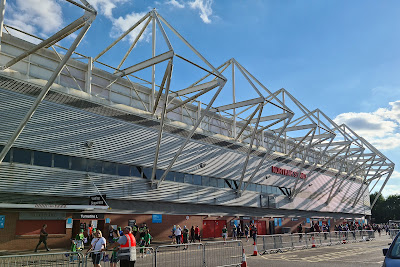A few weeks ago, we delivered an outreach engagement session to a local school, showing Year 7 pupils a selection of plastics objects related to WWII (refer image below).
 |
A selection of the
WWII related objects. Image credit: Katherine Pell |
One of the objects that really caught my attention was the
Wunup Baccyflap, seen in the middle of the top row above, and full image below.
 |
Wunup Baccyflap, AIBDC
: 006319SA Image credit: MoDiP |
The museum’s catalogue record describes it as a round tobacco holder with a screw top lid and inner lip. Moulded in three sections to make the tooling easier, the inner lip is adhered in place. Compression moulded in phenol formaldehyde (bakelite), it dates from the early 1930s-1950s (circa).
If you ever get the chance to handle one of these, you will appreciate just how tactile they are. Resting perfectly in the palm of the hand, I can imagine the design makes filling a pipe both easy and satisfying. The size would fit very neatly into a pocket and the top includes a useful band of match strike. Moulding details on the bottom state WUNUP BACCYFLAP and MADE IN ENGLAND.
There is another Baccyflap in the collection, injection moulded in polystyrene and manufactured by Parker, post 1945 (refer image below).
| Parker Baccyflap, AIBDC : 008640SA Image credit: Katherine Pell |
These two objects are actually linked because although very little information is known about Wunup, the name was either created or acquired by Parker. The Parker Pipe Co. Ltd was formed in 1923 and found initial success through marketing a range of mass-produced smoking accessories under the Wunup brand (the company amalgamated with Hardcastle Pipes Ltd in 1967 to become Parker-Hardcastle). The image below shows an original box for the Wunup Baccyflap promoting both Parker and Wunup, held in the collection of the Deutsches Kunststoff Museum.
 |
Wunup Baccyflap and
box. Image credit: https://www.deutsches-kunststoff-museum.de/sammlung/virtuelles-museum/k-2009-00695/ |
It seems that the Wunup Baccyflap was certainly established
by 1933, when it was advertised for sale at 2/6 in a trade journal, and it
appeared in industry price lists two years later amongst other products sold by
Parker. MoDiP has some other Wunup objects, including a cigarette case (refer image below) with a
spring-loaded compartment and sliding lid, inscribed ‘Parker Wunup. Made in
England’ on the base. It is speculated that the Wunup name may have evolved
from this design because as the lid was pulled back, a cigarette would ‘pop up’
- one up.
 |
Wunup cigarette
case, AIBDC : 006545SA Image credit: MoDiP |
And here is one illustrated with an
original point-of-sale marketing
stand, for use in-store:
 |
Wunup cigarette
case advert. Image credit: https://i.imgur.com/5wzoyzd.jpg |
Parker filed to trademark the Wunup
name in the US in 1946 and anecdotal evidence suggests the Wunup Baccyflap was still
available to buy throughout the 1950s. However, at some point post WWII, Parker
changed the production of this popular tobacco container by moulding their name
into it instead and making it from a completely different plastics material,
likely due to costs. These versions were still available to buy in the early
1970s.
 |
Advertisement for
the Parker Baccyflap Image credit: http://baccyflap.com/txt/baccyflap/ |
If you would
like to view these or any other museum objects, contact
us to make an
appointment.
Katherine Pell
Collections Officer
References:
http://baccyflap.com/txt/baccyflap/
https://books.google.co.uk/books?id=Lc6dAAAAMAAJ&pg=PA20&lpg=PA20&dq=was+wunup+a+company+or+a+brand?&source=bl&ots=C6v_sqJ6t8&sig=ACfU3U0XR_x8FHpDHHpFbzHz192UsWNjkw&hl=en&sa=X&ved=2ahUKEwi3tbj2z_D4AhXtSUEAHXZ8DOIQ6AF6BAgQEAM#v=onepage&q=was%20wunup%20a%20company%20or%20a%20brand%3F&f=false
https://www-alanoblebouffarde-com.translate.goog/t1715p25-wunup-baccyflap?_x_tr_sl=fr&_x_tr_tl=en&_x_tr_hl=en&_x_tr_pto=sc
https://www.deutsches-kunststoff-museum.de/sammlung/virtuelles-museum/k-2009-00695/
https://www-fumeursdepipe-net.translate.goog/artparker.htm?_x_tr_sl=fr&_x_tr_tl=en&_x_tr_hl=en&_x_tr_pto=sc
https://i.imgur.com/5wzoyzd.jpg
https://www.industrydocuments.ucsf.edu/tobacco/docs/#id=pzyg0148
https://pipesmagazine.com/forums/threads/i-just-snagged-a-rare-and-illusive-baccyflap.41450/
http://pipesmokerunlimited.com/archive/index.php/t-9594.html









.jpg)





